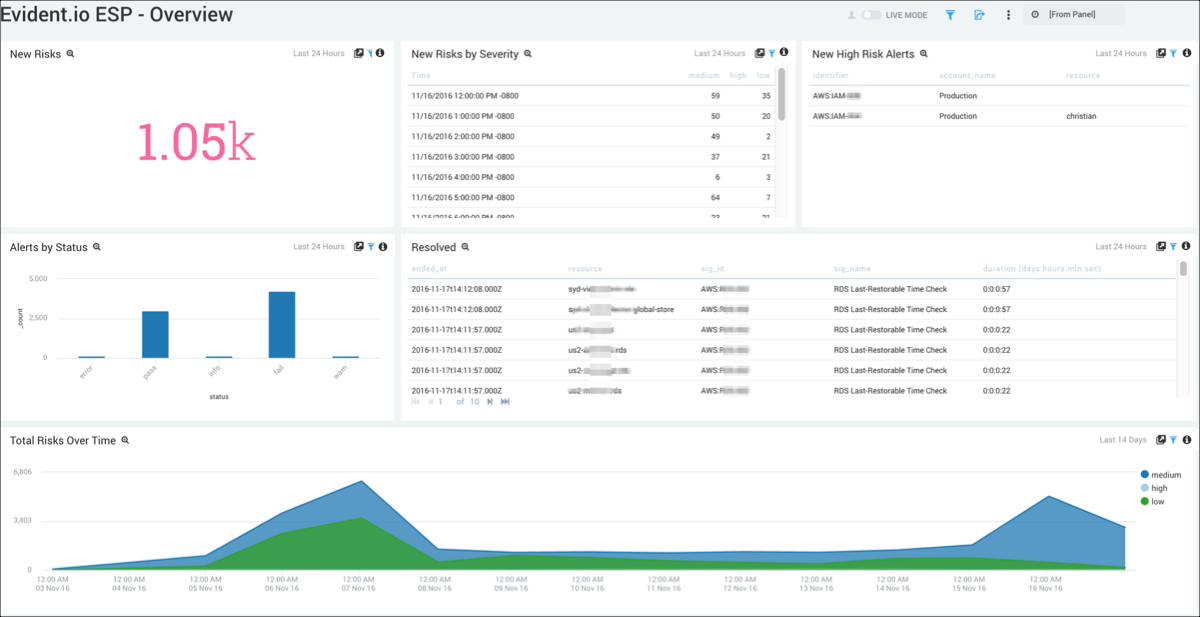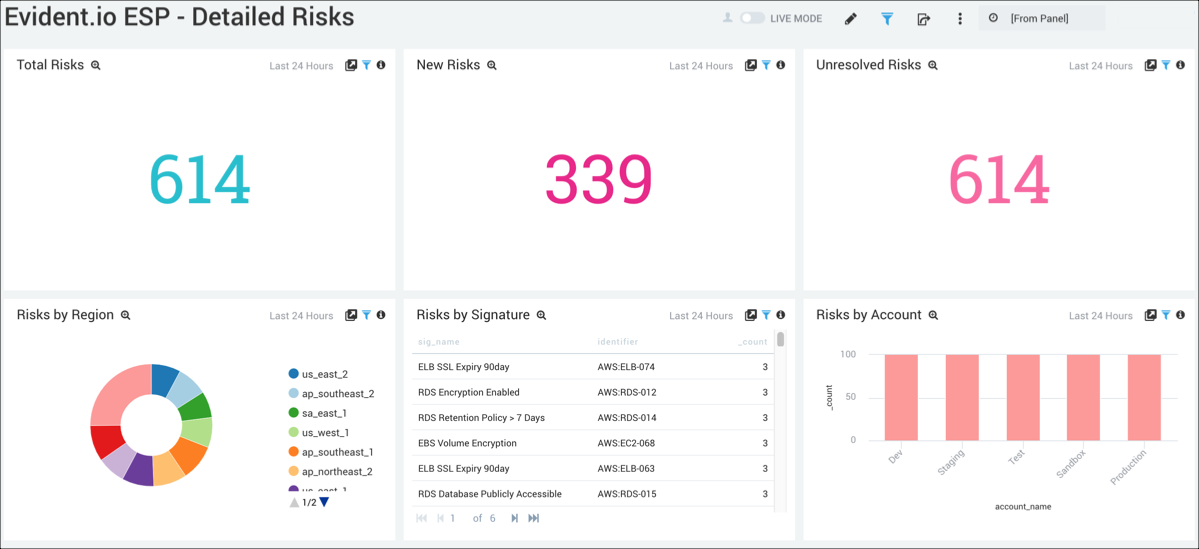Evident.io ESP

The Evident.io ESP App provides pre-configured searches and Dashboards that allow you to investigate Evident-specific events and provide operational visibility to team members without logging into Evident.io.
The Evident.io Evident Security Platform (ESP) streamlines and optimizes vulnerability and risk management. It continuously monitors the AWS cloud, automatically identifies security misconfigurations, enables rapid mitigation of risk through guided remediation and provides visibility to their service through integrations with a central security analytics platform like Sumo Logic. By combining the vulnerability and identified security misconfigurations from Evident and other data sources, you can reduce your security risk and improve your overall security posture.
Log Types
The Evident.io ESP App collects monitoring alerts.
For details on the log format and definitions, refer to Evident.io documentation at http://docs.evident.io/.
Sample Log Message
Click to expand
{
"data":{
"id":"881237069",
"type":"alerts",
"attributes":{
"created_at":"2017-10-02t18:39:11.577Z",
"status":"fail",
"risk_level":"medium",
"resource":"dgadoury",
"updated_at":"2017-10-02t18:39:11.577Z",
"started_at":"2017-10-02T18:39:11.578Z",
"ended_at":null
},
"relationships":{
"external_account":{
"data":{
"id":"3256",
"type":"external_accounts"
},
"links":{
"related":"https://esp.evident.io/api/v2/external_accounts/3256.json"
}
},
"region":{
"data":{
"id":"8",
"type":"regions"
},
"links":{
"related":"https://esp.evident.io/api/v2/regions/8.json"
}
},
"signature":{
"data":{
"id":"83",
"type":"signatures"
},
"links":{
"related":"https://esp.evident.io/api/v2/signatures/83.json"
}
},
"custom_signature":{
"data":null,
"links":{
"related":null
}
},
"suppression":{
"links":{
"related":null
}
},
"metadata":{
"data":{
"id":"262926952",
"type":"metadata"
},
"links":{
"related":"https://esp.evident.io/api/v2/alerts/264543844/metadata.json"
}
},
"cloud_trail_events":{
"data":[
],
"links":{
"related":"https://esp.evident.io/api/v2/alerts/264543844/cloud_trail_events.json"
}
},
"tags":{
"data":[
],
"links":{
"related":"https://esp.evident.io/api/v2/alerts/264543844/tags.json"
}
},
"compliance_controls":{
"links":{
"related":"https://esp.evident.io/api/v2/alerts/2645:43844/compliance_controls.json"
}
}
}
},
"included":[
{
"id":"2433",
"type":"external_accounts",
"attributes":{
"created_at":"2016-03-22t20:55:47.000Z",
"name":"Test",
"updated_at":"2016-10-05t01:05:22.000Z",
"arn":"arn:aws:iam::926226587429:role/Evident_Service",
"account":"123226587429",
"external_id":"62dd0abc-5b44-410b-99d9-063f2c2b203e",
"cloudtrail_name":null
},
"relationships":{
"organization":{
"links":{
"related":"https://esp.evident.io/api/v2/organizations/1000.json"
}
},
"sub_organization":{
"links":{
"related":"https://esp.evident.io/api/v2/sub_organizations/2000.json"
}
},
"team":{
"links":{
"related":"https://esp.evident.io/api/v2/teams/3000.json"
}
},
"scan_intervals":{
"links":{
"related":"https://esp.evident.io/api/v2/external_accounts/5000/scan_intervals.json"
}
}
}
},
{
"id":"8",
"type":"regions",
"attributes":{
"code":"ap_southeast_1",
"created_at":"2014-06-05t23:42:37.000Z",
"updated_at":"2014-06-05t23:42:37.000Z"
}
},
{
"id":"83",
"type":"signatures",
"attributes":{
"created_at":"2014-06-09t22:33:54.000Z",
"description":"Ensure RDS restorable windows are within bounds -- exceeding 5 minutes is problematic.",
"identifier":"AWS:ELB-070",
"name":"ELB SSL Expiry 90day",
"resolution":"RDS Restorable Windows are the timeframe to which the latest data is restorable. If these windows begin to exceed 5 minutes, then something is generally lagging in the system and could be broken. This signature alerts users if the 'latest restorable time' stops working as intended, which increases your potential risk if you need to recover data from your backups. Overall, it is expect to see this alert switch from PASS to FAIL on occasion with ESP due to transient delays from AWS. If this alert fails consistently for one of your accounts, we recommend contacting AWS Support and asking them to take a look. For more information, AWS has information explaining how the Latest Restorable Time impacts your ability to restore a DB instance to a specific point in time http://docs.aws.amazon.com/AmazonRDS/latest/UserGuide/USER_PIT.html",
"risk_level":"Low",
"updated_at":"2016-10-13t00:00:15.000Z"
},
"relationships":{
"service":{
"links":{
"related":"https://esp.evident.io/api/v2/services/10.json"
}
}
}
}
]
}
Sample Query
_sourceCategory=security_evident
| json "data.id", "data.attributes" as id, data_attrib
| json "included.[0].attributes.name" as account_name
| json "included.[1].attributes.code" as region
| json "included.[2].attributes" as sig_attrib
| json field=data_attrib "resource", "status", "started_at", "created_at", "ended_at", "updated_at"
| json field=sig_attrib "description", "identifier", "name", "resolution", "risk_level"
| first(updated_at) by id, status
| count by status
Collecting Logs for the Evident.io ESP App
This page demonstrates how to configure log collection for the Evident.io ESP App, and provides an example log message and query.
Step 1. Add a Sumo Logic Collector and Source
In Sumo Logic, configure a Hosted Collector.
Configure an HTTP Source.
- Name. Enter Evident.io SNS Integration.
- Source Category. Enter security_evident.
In the Advanced section, configure: 3. Enable Timestamp Parsing. Activate the check box Extract timestamp information from log files. 4. Time Zone. Select Ignore time zone from log file, and select (UTC) Etc/UTC
Processing Rules. Create the following Mask Rule: \
- Name. Enable proper timestamp parsing
- Filter. Enter
\"(?:created_at|updated_at|ended_at)\":\"\d+-\d+-\d+(T)\d+:\d+:\d+.\d+Z\" - Type. Select Mask messages that match.
- Mask String. Enter t.
Click Apply.
Click Save.
Copy the HTTP Source Address URL and use it in the following section.
Step 2. Configure an Evident.io Integration with AWS SNS
To configure an Evident.IO Integration with AWS SNS:
- In Evident.io, add an Integration.
- Enable an AWS SNS integration.
Step 3. Subscribe to SNS Notifications
Once the Hosted Collector and HTTP Source are configured, subscribe your Hosted Collector to the topic collecting data from Evident.io.
If this is a new SNS topic, first subscribe an email address to it to make sure the path from ESP to the SNS topic works correctly before subscribing the Hosted Collector.
In the AWS Management Console, go to SNS > Topics, and find the topic you created in Configure an Evident.IO Integration with AWS SNS.
Select the checkbox for the topic.
Under Amazon SNS, in the Actions menu, select Subscribe to Topic.
Under Protocol, select HTTPS, and paste the Sumo Logic HTTP Source URL you created in the first step into the Endpoint field.
Click Create Subscription.
In a few minutes, a confirmation message is sent to Sumo Logic.
In Sumo Logic, find the confirmation message from your HTTP Source by searching for
SubscribeURL. For example, use the query:_sourceCategory=security_evident SubscribeURLThen, in the Messages tab, find the JSON field
SubscribeURL, and copy the URL to your clipboard, as shown.In the AWS Management Console, select SNS >Topics.
Under Amazon SNS > Actions, select Confirm a subscription.
Paste the
SubscribeURLinto the field Subscription confirmation URL, and click Confirm subscription.
Step 4. Enable Raw Message Delivery
Enable Raw Message Delivery for the topic.
For details, see http://docs.aws.amazon.com/sns/latest/dg/large-payload-raw-message.html.
- Select the AWS Topic.
- Click Other subscription actions.
- Click Edit subscription attributes.
- Select the Raw message delivery check box.
- Click Set subscription attributes.
Installing the Evident.io ESP App
Now that you have configured Evident.io ESP, install the Sumo Logic App for Evident.io ESP to take advantage of the preconfigured searches and dashboards to analyze your data.
To install the app:
Locate and install the app you need from the App Catalog. If you want to see a preview of the dashboards included with the app before installing, click Preview Dashboards.
- From the App Catalog, search for and select the app.
- Select the version of the service you're using and click Add to Library. Version selection is applicable only to a few apps currently. For more information, see Installing the Apps from the Library.
- To install the app, complete the following fields.
- App Name. You can retain the existing name, or enter a name of your choice for the app.
- Data Source. Select either of these options for the data source.
- Choose Source Category, and select a source category from the list.
- Choose Enter a Custom Data Filter, and enter a custom source category beginning with an underscore. Example: (
_sourceCategory=MyCategory).
- Advanced. Select the Location in Library (the default is the Personal folder in the library), or click New Folder to add a new folder.
- Click Add to Library.
Once an app is installed, it will appear in your Personal folder, or other folder that you specified. From here, you can share it with your organization.
Panels will start to fill automatically. It's important to note that each panel slowly fills with data matching the time range query and received since the panel was created. Results won't immediately be available, but with a bit of time, you'll see full graphs and maps.
Viewing Evident.io Dashboards
Evident.io ESP - Overview

New Risks. Displays the number of new risks in a single value chart over the previous 24 hours.
New Risks by Severity. Shows the severity of new risks in a stacked column chart on a timeline for the last 24 hours.
New High Severity Risks. Provides details on the new high severity risks in a table chart over the last 24 hours.
Alerts by Status. Provides details on the number and status of new alerts over the last 24 hours in a column chart
Resolved Risks. Shows which risks have been resolved over the last 24 hours in a table chart.
Total Risks over Time. Shows a trendline of all alerts over the last 14 days in a stacked area chart.
Evident.io ESP - Detailed Risks

Total Risks. Shows the number of total risks in a single value chart over the last 24 hours
New Risks. Displays the number of new risks for the last 24 hours in a single value chart.
Unresolved Risks. Displays the number of unresolved risks reported over the last 24 hours in a single value chart.
Risks by Region. Displays the total number of risks by region over the last 24 hours in a donut chart.
Risks by Signature. Provides details on risks by signature name and identifier over the last 24 hours in a table chart.
Risks by Account. Displays the total number of risks by account name over the last 24 hours in a column chart.